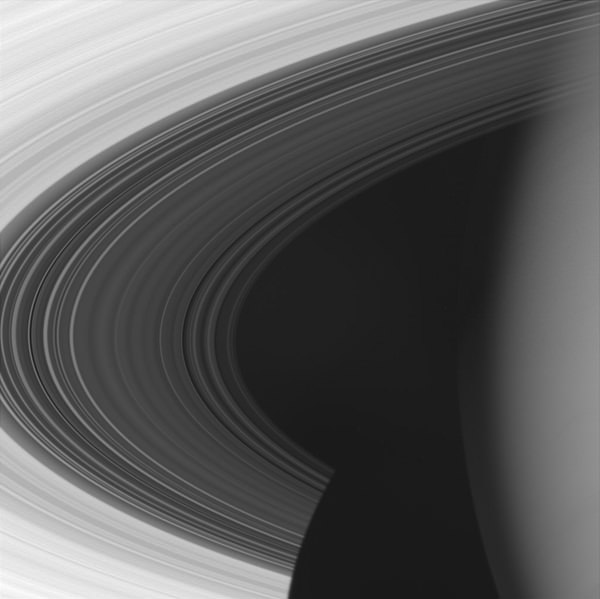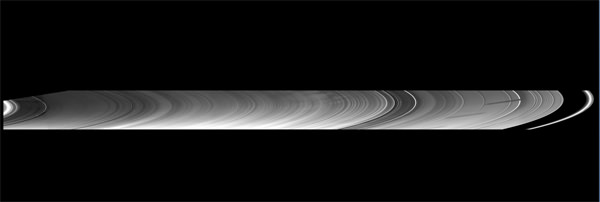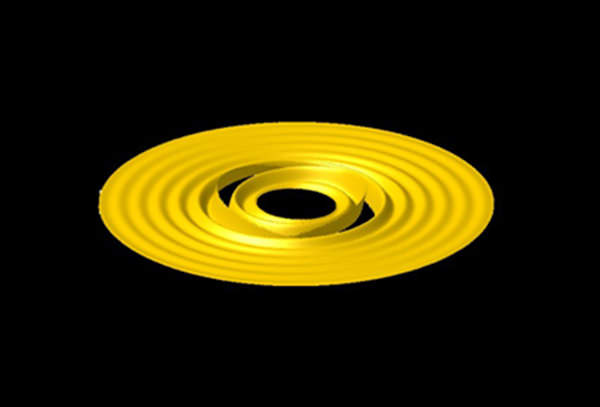[/caption]
Saturn’s rings have several gaps, most of which are caused by small moons shepherding ring debris into breaks in the rocky rings. But one gap may be caused by gravitational perturbations from Saturn’s largest moon, Titan, sending tsunami-like waves up to 3 kilometers (2 miles) high in the C ring. This causes one region of the ring to spin like a warped, uneven vinyl record on a turntable. A new model of this action explains why the gap was narrower than expected and also why is seems to disappear from time to time. “What looked like a 15-kilometer-wide gap actually was this gap with a vertical displacement of about 3 kilometers projected and seen almost edge on,” said Phillip Nicholson from Cornell University, speaking at a press briefing at the American Astronomical Society’s Division for Planetary Sciences meeting in Pasadena, California. “It’s a little like a tsunami propagating away from an earthquake fault.”

The gap in the middle of the C ring has been known since Voyager 1 flew by Saturn in the 1980, and it appeared there was a 15 km-wide gap. But when Cassini arrived in 2004 and began observations, the gap was only 2 km (1.5 miles) and sometimes it wasn’t there at all.
Nicholson said only when they began to think in three dimensions were they able to solve the mystery of this gap. While most of Saturn’s rings are flat, in 2009, the angle of sunlight during Saturn’s spring equinox revealed there were lumps and bumps in the rings are as high as the Rocky Mountains.
The model Nicholson and colleagues created suggests the actual gap in the ring is about a half a kilometer wide, but part of the ring rises 3 km (2 miles) in the air up. The different angles the two spacecraft observed from made the gap look wider to Voyager than to Cassini.
“The whole pattern rotates around at the same rate as the satellite Titan orbits Saturn, once every 16 days,” said Nicholson said. Sometimes, the tsunami-like wave couldn’t be seen by the spacecraft, which accounts for how the gap seems to appear and disappear.
Nicholson said this model explains the C ring gap, “better than you have any right to expect,” but there could be three or four dynamical processes going on that explains the other gaps.
Nicholson and Cassini Deputy Project Scientist Linda Spilker said the same types of processes seen in Saturn’s rings could also explain what is seen in disks of debris around other stars, with the theory that there are gaps forming in the disks associated with the formation of planets.

“Saturn provides a wonderful natural laboratory of how protoplanetary nebula may evolve,” said Spilker.
The Cassini scientists also noted how the Cassini mission has now moved past the “Equinox” mission and is now in another extension of the mission called the Solstice mission, which will keep the spacecraft going until 2017.
Spilker shared how as the end of the mission approaches, they might try some riskier moves, such as try flying between Saturn’s D ring or heading into Saturn’s into upper atmosphere to “study new things about planet itself, for the end of the mission.”
Source: DPS meeting webcast


Dear Nancy:
1. Cassini was launched in 1997, and arrived in 2004.
2. Does it have anything to do with the Colombo gap (with its included Titan ringlet)?
What air? In the aether, you mean?
😉
Good point!
@Luis-
1. I obviously wrote this article late at night when tired. (thanks)
2. Nicholson did not mention anything about the Colombo gap during his short talk at the press briefing.
Satellites close to rings may have tidal effects
These phenomena are fascinating, and there is a lot of interesting non-linear and “turbulent” physics involved. Thank you, Nancy, for your report.
Question:
Saturn’s seasons, like Spring, and the interaction with the Sun; Would the planet emit an electromagnetic wave or a pulsating gravity (up and down) thread that could create this wave? I did think about the ring it’s self, but, it looks to be emitting from the planet in a uniform pulsating manor. Like liquid metals can… I hope it’s cool
to ask as I am sure that you have a great answer. Thank you.